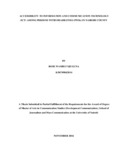| dc.contributor.author | Njuguna, Rose W | |
| dc.date.accessioned | 2017-01-05T07:03:22Z | |
| dc.date.available | 2017-01-05T07:03:22Z | |
| dc.date.issued | 2016 | |
| dc.identifier.uri | http://hdl.handle.net/11295/99022 | |
| dc.description.abstract | This study sought to investigate the accessibility to information and communication technology among Persons with Disabilities in Nairobi County, Kenya. The study was guided by two specific objectives; to find out the ICTs that are adopted by PWDs in Nairobi County and investigate sustainability of ICTs adopted by PWDs in Nairobi County. The study adopted the Capability Theory and Social Constructivist Theory to guide the research. The research was a descriptive survey and adopted both qualitative and quantitative approaches of data collection. The stratified random sampling procedure was adopted in this study. The sample size for the study was 381. A semi-structured questionnaire was adopted as the primary tool for collecting data. It was administered to the persons with disabilities and was used for the purposes of collecting primary quantitative data. The study was able to collect 160 questionnaires and three key informants were conducted from 3 members from the Kenya disability web portal. The findings revealed that the most used ICTs among PWDs were mobile phone/television and radio/mobile phones. The study found that PWDs wish they could use internet connected ICTs. The respondents also cited that they would wish to use portable internet accessible devices. The study found that limited training on device use and rehabilitation services was the major barrier in PWDs use of ICTs. Affirmative action and waiver of taxes on ICTs for PWDs was cited as the most significant intervention to enhance sustainability of PWDs use of ICTs. The study concluded that there is need for ICT training for PWDs in order to bridge the digital divide between PWDs and their able-bodied peers. The study further concluded that granting of privileges for PWDs was the best way for PWDs to be able to access and use ICTs. The study recommends that the government should stimulate the introduction of ICT-enabled solutions for persons with disabilities, increasing the availability of accessible ICTs and promoting the affordability of assistive technologies. Policy makers can address market failure in assistive technology through public interventions and mandatory incorporation of accessibility requirements into public procurement policies. Business entities should design, manufacture, develop and distribute into the market key ICT-enabled solutions for persons with disabilities and civil society organizations can bring about awareness of persons with disabilities and their parents of what ICTs can do to bring about their economic and social integration. | en_US |
| dc.language.iso | en | en_US |
| dc.publisher | University of Nairobi | en_US |
| dc.rights | Attribution-NonCommercial-NoDerivs 3.0 United States | * |
| dc.rights.uri | http://creativecommons.org/licenses/by-nc-nd/3.0/us/ | * |
| dc.title | Accessibility to information and communication technology (ict) among persons with disabilities (PWDS) in Nairobi county | en_US |
| dc.type | Thesis | en_US |



